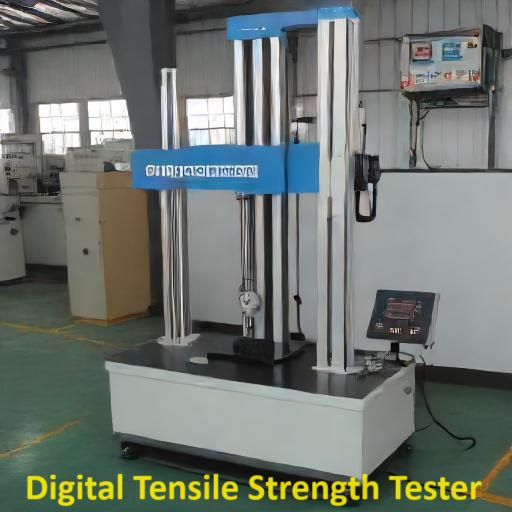Tensile testing is a fundamental materials science test in which a sample is subjected to a controlled tension until failure. The results from this test are used to determine several properties of the material, including tensile strength, elongation, and Young’s modulus. With the advent of digital technology, the tensile testing process has evolved significantly, leading to the development of digital tensile strength testers. These advanced machines offer greater accuracy, ease of use, and enhanced data processing capabilities compared to their analog counterparts.
Components and Working Principles of
Deformation Measuring Device:
A key component of the digital tensile strength tester is the deformation measuring device. This device measures the deformation of the specimen during the test. It includes two chucks connected to a photoelectric encoder via a series of transmission mechanisms. When the distance between the two chucks changes due to the tensile force, the axis of the photoelectric encoder rotates. This rotation generates a pulse signal, which is processed by a microcontroller to determine the deformation of the sample.
The photoelectric encoder is critical in converting mechanical displacement into electronic signals. As the sample stretches, the encoder provides precise measurements of the deformation, ensuring accurate data collection. This data is crucial for calculating the material’s tensile strength and other mechanical properties.
Displacement Measurement System for Beam
The displacement measurement system for the beam operates on a similar principle as the deformation measuring device. The system uses the output pulse number from the photoelectric encoder to measure the displacement of the beam. This system ensures that the movement of the beam, driven by the servo system motor, is accurately tracked.
The beam’s displacement is an essential parameter in tensile testing. It helps in understanding how the material behaves under stress and the extent to which it can elongate before breaking. Accurate measurement of beam displacement ensures reliable and repeatable test results.
Drive System:
The drive system in a digital tensile strength tester is responsible for the movement of the test machine’s beam. This system is controlled by a servo motor, which drives the beam through a gearbox and a series of transmission mechanisms. The rotation of the screw controls the beam’s movement, allowing precise control over the speed and position of the beam.
By adjusting the motor’s speed, the operator can control the rate at which the beam moves. This capability is crucial for conducting tests at different strain rates, which can influence the material’s mechanical properties. The drive system’s precision ensures that the tensile test is conducted under controlled conditions, providing reliable data.
Control System:
The control system of the digital tensile strength tester allows the operator to manage the entire testing process. Through a console, the operator can start and stop tests, adjust test parameters, and monitor the machine’s status. Modern digital testers often include a computer interface, allowing for enhanced data processing and analysis.
The communication between the test machine and the computer is typically handled via RS232 serial communication, a mature and reliable technology. This connection enables the transfer of test data to the computer, where it can be analyzed and stored. The control system’s interface is designed to be user-friendly, making it easy for operators to conduct tests and interpret results.

Computer Host:
The computer host plays a pivotal role in data collection and analysis. During a test, the computer continuously collects various data points, such as load, displacement, and deformation. It then processes this data in real-time to generate test curves and calculate key parameters like tensile strength, yield strength, and elongation at break.
The ability to visualize data in real-time is one of the significant advantages of digital tensile strength testers. Operators can observe the material’s behavior during the test, allowing for immediate identification of any anomalies or unexpected results. The computer can also generate detailed test reports, which can be printed or stored electronically for future reference.
Advantages of Digital Tensile Strength Testers
Accuracy and Precision:
Digital tensile strength testers offer superior accuracy and precision compared to traditional analog machines. The use of photoelectric encoders and digital data processing ensures that measurements are highly accurate and repeatable. This precision is crucial for quality control and research applications, where small variations in material properties can be significant.
Real-Time Data Analysis
One of the standout features of digital tensile strength testers is the ability to perform real-time data analysis. As the test progresses, the machine continuously collects data and updates the test curves. This immediate feedback allows operators to monitor the test in real-time and make adjustments if necessary. Real-time analysis also facilitates quicker decision-making, improving the efficiency of the testing process.
Enhanced Data Storage and Reporting
Digital tensile strength testers can store large amounts of data electronically. This capability simplifies data management and ensures that test records are easily accessible for future reference. Detailed test reports can be generated automatically, reducing the time and effort required for manual data entry and report preparation. These reports can include graphs, tables, and statistical analyses, providing a comprehensive overview of the test results.
User-Friendly Interface
Modern digital tensile strength testers are designed with user-friendly interfaces, making them accessible to operators with varying levels of expertise. The control systems are intuitive, often featuring touch screens and graphical displays that simplify the setup and execution of tests. This ease of use reduces the likelihood of operator error and enhances the overall efficiency of the testing process.
Versatility
Digital tensile strength testers are versatile machines capable of testing a wide range of materials, including metals, polymers, composites, and textiles. The ability to configure the machine for different types of tests, such as tension, compression, and bending, makes it a valuable tool for various industries, from aerospace and automotive to construction and manufacturing.

Applications of Digital Tensile Strength Testers
Quality Control
In manufacturing, ensuring the quality of materials is paramount. Digital tensile strength testers are extensively used in quality control laboratories to verify that materials meet specified standards and regulations. By providing accurate and reliable data, these machines help manufacturers maintain high-quality products and reduce the risk of material failure in the field.
Research and Development
In research and development (R&D), understanding the mechanical properties of new materials is essential. Digital tensile strength testers enable researchers to conduct detailed studies on material behavior under different loading conditions. The precise data obtained from these tests can be used to develop new materials with enhanced properties and to optimize existing materials for specific applications.
Compliance with Standards
Many industries are subject to strict regulatory standards that dictate the mechanical properties of materials. Digital tensile strength testers are used to ensure compliance with these standards by providing accurate and reliable test results. This compliance is critical for industries such as aerospace and medical devices, where material failure can have catastrophic consequences.
Educational Purposes
Educational institutions use digital tensile strength testers to teach students about material science and engineering principles. These machines provide a hands-on learning experience, allowing students to conduct experiments and observe the mechanical behavior of different materials. The data collected from these tests can be used to reinforce theoretical concepts and enhance the learning process.
Future Trends in Digital Tensile Strength Testing
Integration with Advanced Technologies
The future of digital tensile strength testing lies in the integration of advanced technologies such as artificial intelligence (AI) and machine learning. These technologies can enhance data analysis by identifying patterns and trends that may not be immediately apparent. AI-driven analysis can lead to the development of predictive models, allowing for more efficient material design and testing processes.
Improved Automation
Automation is another trend that will shape the future of tensile strength testing. Fully automated testing systems can perform tests without human intervention, reducing the likelihood of operator error and increasing throughput. Automated systems can also handle large volumes of tests, making them ideal for high-demand environments such as manufacturing and R&D laboratories.
Enhanced Connectivity
With the rise of the Internet of Things (IoT), digital tensile strength testers are becoming increasingly connected. Enhanced connectivity allows these machines to integrate seamlessly with other laboratory equipment and management systems. This integration can streamline workflows, improve data sharing, and facilitate remote monitoring and control of the testing process.
Miniaturization and Portability
As technology advances, there is a trend towards the miniaturization and portability of testing equipment. Portable digital tensile strength testers can be used in the field, providing immediate testing capabilities without the need for transporting samples to a laboratory. This portability is particularly beneficial for industries such as construction and aerospace, where on-site testing can save time and resources.
Conclusion:
Digital tensile strength testers represent a significant advancement in materials testing technology. Their ability to provide accurate, real-time data, combined with user-friendly interfaces and enhanced data processing capabilities, makes them indispensable tools in various industries. As technology continues to evolve, these machines will become even more sophisticated, integrating advanced technologies and improving automation and connectivity. The future of tensile testing is undoubtedly digital, promising greater efficiency, accuracy, and versatility in material characterization.
Frequently Asked Questions (FAQ’s)
What is the working principle of tensile strength test?
The working principle of a tensile strength test involves applying a uniaxial force to a specimen and measuring its response to the force. The specimen is usually gripped at both ends and pulled apart until it breaks. The force applied and the elongation of the specimen are recorded throughout the test. The stress-strain curve is then generated, providing insights into the material’s tensile properties, such as tensile strength, yield strength, and elongation at break.
What is the working principle of testing machine?
The working principle of a testing machine, such as a universal testing machine (UTM), involves applying controlled force to a specimen and measuring its response. The machine typically consists of a load cell to measure force, a crosshead to apply the force, and an extensometer or other displacement measuring devices to measure deformation. The data collected during the test is used to calculate mechanical properties like strength, elasticity, and ductility.
How does tensile strength work?
Tensile strength is the maximum stress a material can withstand while being stretched or pulled before breaking. It works by quantifying the maximum amount of tensile stress the material can endure before failure. During a tensile test, the material is subjected to increasing tension until it fractures, and the highest stress value recorded before breaking is the tensile strength.
How does a tensile tester work?
A tensile tester works by clamping a test specimen in grips or fixtures and then applying a tensile force using a moving crosshead. The machine measures the applied force and the elongation of the specimen. The force is applied until the specimen breaks, and the data is recorded to generate a stress-strain curve, which is used to determine the tensile properties of the material.
How to calculate tensile strength?
Tensile strength is calculated using the formula:
Tensile Strength=Maximum Load / Cross-Sectional Area,
Where Maximum Load where the maximum load is the highest force applied to the specimen before failure, and the cross-sectional area is the original area of the specimen’s cross-section perpendicular to the load.
What are the applications of tensile strength?
Applications of tensile strength include:
- Quality control and material certification in manufacturing
- Designing and engineering structures and components
- Research and development of new materials
- Ensuring compliance with industry standards
- Predicting material behavior under load in various industries like aerospace, automotive, construction, and textiles
How does a strength test work?
A strength test works by applying a controlled force to a material or structure and measuring its response. This can include tensile tests, compressive tests, and flexural tests. The test helps determine the material’s mechanical properties, such as strength, ductility, and toughness.
What are the 7 principles of testing?
The seven principles of software testing are:
- Testing shows the presence of defects
- Exhaustive testing is impossible
- Early testing saves time and money
- Defects cluster together
- Beware of the pesticide paradox
- Testing is context-dependent
- Absence-of-errors fallacy
What is the principle of working machine?
The principle of a working machine involves converting energy into mechanical work to perform a specific task. This involves a power source, transmission mechanisms, and control systems to direct the machine’s operation efficiently and effectively.
How does a QA tester work?
A QA (Quality Assurance) tester works by designing, executing, and analyzing tests to ensure software meets specified requirements and is free of defects. QA testers use various testing methods, such as manual testing, automated testing, performance testing, and regression testing, to identify issues and verify the software’s functionality, usability, and performance.
What is the principle of tensile strength?
The principle of tensile strength is that it measures the maximum tensile stress a material can withstand before failure. It reflects the material’s ability to resist breaking under tension and is determined through a tensile test.
What is test principle?
A test principle refers to the fundamental concept or rationale behind conducting a test. It involves verifying that a system or component performs as expected under specified conditions, identifying defects, and ensuring reliability, functionality, and performance.
How does a universal tensile testing machine work?
A universal tensile testing machine works by gripping a test specimen and applying a tensile force through a moving crosshead. The machine measures the force applied and the elongation of the specimen. The data collected is used to generate a stress-strain curve, which helps determine the material’s mechanical properties like tensile strength, yield strength, and elasticity.
What is the basic working principle?
The basic working principle refers to the fundamental mechanism by which a device or process operates. For example, in mechanical systems, it often involves converting energy into mechanical work using principles of physics, such as force, motion, and energy transfer.
What is the work principle?
The work principle is the core concept or fundamental mechanism that dictates how a device or process functions. It involves the underlying laws of physics or logic that enable the operation of the system or device.
What is the working principle formula?
The working principle formula refers to the mathematical expression that describes the fundamental operation of a device or system. For example, in physics, work is calculated as:
Work=Force × Distance
Which testing is best?
The best type of testing depends on the context and requirements of the project. Common types of testing include:
- Functional testing for verifying software functions
- Performance testing for assessing speed and scalability
- Security testing for identifying vulnerabilities
- Usability testing for evaluating user experience
What is the test process?
The test process typically includes the following stages:
- Planning: Define test objectives, scope, and strategy.
- Design: Create test cases and test scripts.
- Implementation: Set up the test environment and tools.
- Execution: Run the tests and collect data.
- Reporting: Document and analyze test results.
- Closure: Summarize findings and ensure all issues are resolved.
What are the types of testing?
Types of testing include:
- Unit testing
- Integration testing
- System testing
- Acceptance testing
- Performance testing
- Security testing
- Usability testing
- Regression testing
Is QA a test or QC?
QA (Quality Assurance) is not the same as QC (Quality Control). QA focuses on ensuring that processes are followed to maintain quality, while QC involves actual testing of products to identify defects.
What is the full form of QA?
The full form of QA is Quality Assurance.
How does a tester work?
A tester works by following a test plan to execute tests on software or hardware to identify defects. They use various tools and techniques to simulate different scenarios, record results, and report issues to ensure the product meets specified requirements.
What is the equation for power and energy?
The equation for power is:
Power=Work / Time
Energy=Power×Time
What is QA testing called?
QA testing is often referred to as quality assurance testing or software testing.
What are the 4 types of test?
The four main types of tests are:
- Unit tests
- Integration tests
- System tests
- Acceptance tests
What is a Type 3 test?
A Type 3 test often refers to a specific category within a broader testing framework, such as complex system testing or integration testing, but the specific definition can vary based on the context.
What is the formula for tensile test?
The formula for tensile strength in a tensile test is:
Tensile Strength=Maximum Load / Cross-Sectional Area
What is the purpose of tensile testing?
The purpose of tensile testing is to determine the mechanical properties of materials under tensile stress, such as tensile strength, yield strength, elongation, and Young’s modulus. It helps in assessing the material’s suitability for specific applications.
What is the use of tensile strength tester?
A tensile strength tester is used to measure the tensile strength and other mechanical properties of materials. It is used in quality control, research and development, and compliance testing to ensure materials meet specified standards and performance requirements.
What is the concept of tensile strength?
The concept of tensile strength refers to the maximum stress a material can withstand while being stretched or pulled before breaking. It indicates the material’s resistance to tension and is a critical property for structural and load-bearing applications.
What is tensile test ratio?
Tensile test ratio often refers to the ratio of different parameters measured during the tensile test, such as the ratio of stress to strain (Young’s modulus) or the ratio of elongation to original length (strain).
Why do we measure tensile strength?
We measure tensile strength to understand the material’s behavior under tensile loads, determine its mechanical properties, ensure it meets design and safety requirements, and assess its suitability for specific applications.



